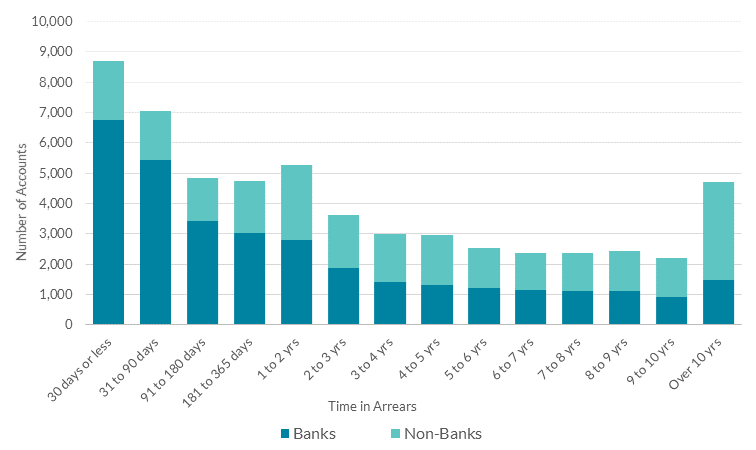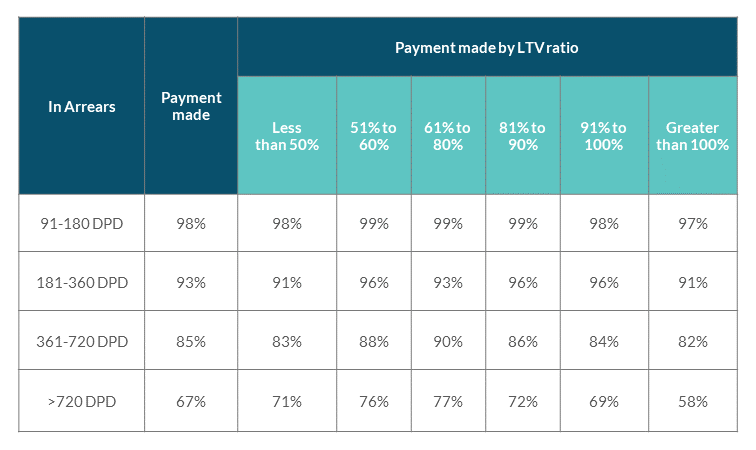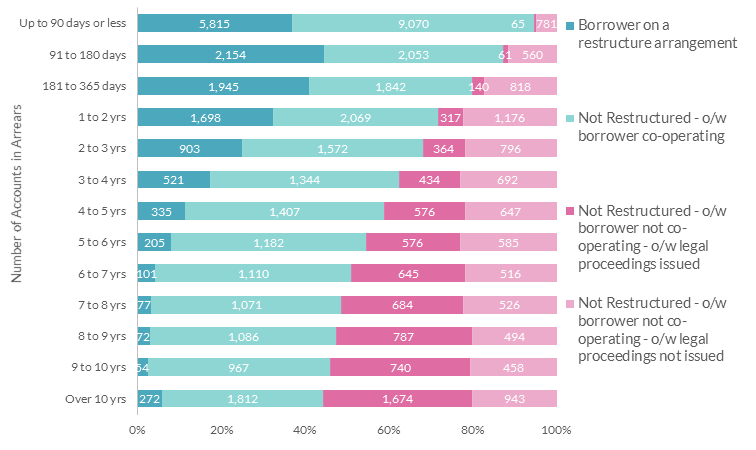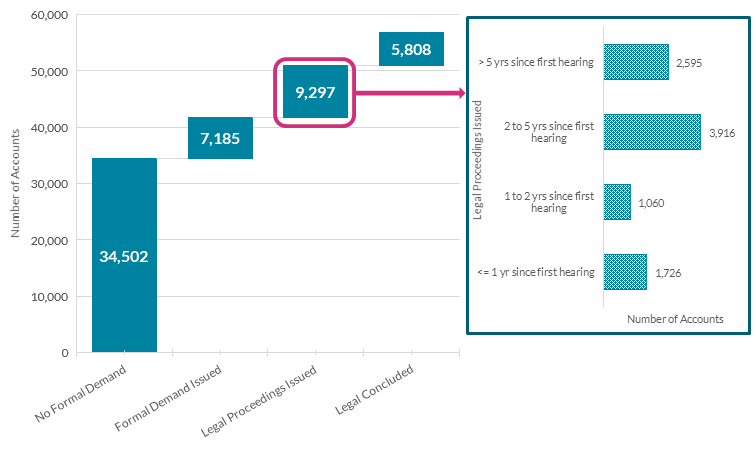Behind the Data

Understanding Long-term Mortgage Arrears in Ireland
David Duignan, Andrew Hopkins, Ciaran Meehan and Martina Sherman*
September 2020
New data on long-term mortgage arrears reveals a significant number are more than ten years in arrears, with such cases dating back to the last financial crisis.
The COVID-19 global pandemic has resulted in an unprecedented shock to Ireland’s economy and society in general. Approximately half a million private sector employees were reliant on government financial support at the end of August, while the economic outlook remains highly uncertain. Additionally, eight per cent of all principal dwelling house (PDH) mortgage accounts in Ireland had some level of arrears when entering the pandemic. While the arrears level has fallen considerably in recent years, it remains elevated, with long-term arrears cases accounting for a large share of those with repayment difficulties.
Recent Central Bank analysis shows that approximately 10 per cent of Irish mortgage holders availed of the COVID-19 payment breaks and, although close to half of those have since returned to making full payments, the full extent of any repayment difficulties won’t be clear until their expiration. The ending of payment breaks or the continuing economic impact of the pandemic more widely, has the potential to increase the number of people in arrears.
Given the sustained levels of longer-term arrears since the 2008 financial crisis, coupled with the ongoing COVID-19 shock, a deeper understanding of this arrears category is important. Drawing on enhanced arrears data collected by Central Bank of Ireland, this “Behind the Data” (BTD) examines those currently in long-term arrears and aims to bring further insight to these pre-COVID-19 legacy arrears cases, which will help to inform future analysis and policy discussion of the issue.
The Data
These data are part of an enhancement to the publicly available Residential Mortgage Arrears and Repossessions Statistics, which was undertaken following a review of data gaps and emerging user needs.
This BTD focuses on a subset of this most recent expansion and data relates to end-June 2020. Analysis focuses on mortgage accounts and, while noted that a household or property may have more than one account (e.g. top-up account), it allows for comparison and consistency with existing data. In broad terms, for mortgage accounts in arrears there is an average of 1.2 accounts per underlying property.
This note concentrates on developments in PDH mortgage accounts only. Data relate to all Irish residential mortgages held or serviced by firms in the Republic of Ireland, including retail banks, retail credit firms, and credit servicing firms. For the purposes of this BTD, retail credit firms and credit servicing firms will be termed “non-banks”. Long-term arrears are defined as those in arrears of more than 720 days (two years). The enhanced data presented in this paper will be incorporated into the existing mortgage arrears publication tables before end-October.
The data source for analysis of payments made on mortgage loans is derived from the granular loan-level data collected from the five retail banks only, and is not part of the enhanced regular mortgage arrears data collection. While the retail banks currently only hold 44 per cent of mortgage accounts in long-term arrears, the analysis gives additional insight not found elsewhere.
A significant number of mortgages in arrears greater than five years, with 1 in 12 in arrears over ten years
Recent years have been characterised by a decline in overall mortgage arrears as both Central Bank policy and lenders sought better resolutions, while a strengthening economy also contributed. Analysis has shown that, taken together, these actions were found to be the primary driver of overall mortgage arrears reduction between 2008 and 2016 (McCann 2018). Despite this decline, remaining arrears cases are increasingly concentrated in the longer-term arrears cohort. Of the 41,061 accounts currently in arrears of over 90 days, 64 per cent are in arrears for more than two years, up from 54 per cent in 2015. To date, there has been no comprehensive data published to cover all entities in the residential mortgage market and to outline the scale and breakdown of the arrears in this cohort.
Chart 1: PDH mortgage accounts in arrears, as held by banks and non-banks

Source: Central Bank of Ireland Quarterly Residential Mortgage Arrears and Repossessions Statistics.
Chart Data: View the data underlying the chart.
Almost one-third of all past due accounts are over five years in arrears, while eight per cent are more than ten years in arrears (Chart 1). This means borrowers have accrued arrears on their mortgage equivalent to ten years of repayments.
Previous research by Donnery et al. (2018), found that for the subset of mortgages held by retail banks in 2017, 44 per cent of long-term arrears loans were more than five years past due. Owing to the sales of deeply distressed loans in interim years, non-banks now hold a greater proportion of accounts in long-term arrears compared with banks, and represent just over two-thirds of all accounts with accumulated arrears equivalent to ten years of payments (Chart 1).
One-third of those in long-term arrears making no mortgage repayment
In many cases, borrowers in arrears may be currently making a partial or even full repayment. Loan-level data, covering the five retail banks only, indicates a significant variation in the proportion of accounts making a payment depending on the length of time in arrears (Table 1). In contrast to mortgage accounts in shorter-term arrears, just two-thirds of those in arrears of over two years made some payment towards their mortgage in the six-months of loan data analysed.
Table 1: Payments made by PDH mortgage accounts in arrears between June and December 2019

Source: Central Bank of Ireland confidential loan-level data, author’s calculations.
Notes: Data relate to the Irish retail banks only. DPD refers to days past due. “Payment made” denotes where a borrower has made a partial or full repayment between June and December 2019. Excludes borrowers availing of a payment moratoria and mortgages with an outstanding balance below €10,000
Looking at the distribution of long-term arrears by current loan-to-value (LTV) ratio, a lower percentage of borrowers in negative equity (i.e. greater than 100% LTV) have made a full or partial payment between June and December 2019 compared with those with higher equity. O’Malley (2018) noted that, as at December 2017, the average account in long-term arrears has a high estimated LTV ratio. The research also finds that those in long-term arrears tend to have a larger repayment burden than those who have exited arrears, and are located in parts of the country with the largest falls in income since the mid-2000s.
Lack of engagement from almost half of borrowers in long-term arrears
Engagement between borrowers in financial difficulty and the holder of their loans has been found to be an important step in the successful resolution of mortgage arrears (McCann & McGeever, 2018), while analysis relating to the retail banks has shown that those in long-term arrears have poor engagement rates (McCann, 2018). In assessing the current level of engagement across all lenders, data on the classification of arrears by those restructured and those “not co-operating” are analysed, including whether legal proceedings have been initiated (Chart 2).
Chart 2: PDH Borrower engagement by arrears cohort

Source: Central Bank of Ireland Quarterly Residential Mortgage Arrears and Repossessions Statistics.
Notes: “Co-operation” status is defined in line with the Code of Conduct on Mortgage Arrears (CCMA), which sets out strict criteria in relation to when loan owners can classify borrowers as not co-operating. In such cases, loan holders must formally notify the borrower of the implications of being classified as not co-operating, including that it may commence legal proceedings for repossession of the property.
Chart Data: View the data underlying the chart.
The 2018 review of effectiveness of the Code of Conduct on Mortgage Arrears (CCMA) found that as many as two-thirds of those in long-term arrears, and not part of a restructure, were classified as not co-operating. This high-level share of non-engagement has reduced somewhat and now stands at just over half.
A closer look at the different arrears cohorts shows that the higher the arrears accumulated, the more likely it is that a borrower is not in a current restructure arrangement, and is classified as not co-operating. Analysis by McCann (2018), using 2016 data on the retail banks, finds that of the majority of borrowers that exited arrears, 90 per cent had a restructure arrangement in place, with very few borrowers exiting arrears through “self-curing”, or without a restructure. Along with the importance of engagement, this highlights the challenge of exiting arrears for the 4,429 accounts with over ten years arrears which are not in a restructure, whether engaging with their lender or not.
Just over one-quarter of borrowers in the legal system are there over five years
While many of those in long-term arrears, and not engaging with their lender have had legal proceedings initiated (Chart 2), the majority of borrowers in mortgage arrears are outside of the legal system. Of all accounts in mortgage arrears, lenders report that 9,297 (16 per cent) are currently part of the legal process, which includes cases at Civil Bill lodgement stage, or where the case is still active in the court's system (Chart 3).
Chart 3: Legal status of PDH mortgage accounts in arrears

Source: Central Bank of Ireland Quarterly Residential Mortgage Arrears and Repossessions Statistics.
Note: Formal demand refers to the issuing of a legal letter for demand. Legal concluded refers to accounts who have concluded legal proceedings, and currently have an outstanding arrears balance.
Chart Data: View the data underlying the chart.
The length of time spent within the Irish court's system is significant, according to the data reported by lenders (Chart 3). The majority of active cases had their first court hearing date more than two years ago, with some 2,595 of those accounts in the court's system for over five years.
Over the last four quarters, an average of 458 mortgage accounts have concluded legal proceedings per quarter. This includes cases where an order for possession/sale has been obtained or legal proceedings have concluded for other reasons, including cases settled on other terms, or cases struck out or withdrawn. The lengthy duration of the legal process likely means that a significant number of borrowers may remain in long-term arrears for the foreseeable future.
Conclusion
Using the enhanced mortgages arrears collection, this BTD presents some further insights into the persistently high number of PDH mortgages that remain in long-term arrears some ten years on from the financial crisis. One-third of borrowers in long-term arrears are more than five years past due, and a substantial number have made no payments on their mortgage. The engagement levels appears to have improved since 2018 but substantial numbers are not deemed to be engaging with the loan holder. Additionally, the length of time cases remain in the legal system indicates that this is not currently a quick method for the resolution of many of these cases. The findings from this note will assist future analysis on household resilience, particularly on this long-term arrears cohort as the impact of the ongoing COVID-19 pandemic unfolds.
* Email [email protected] and [email protected] if you have any comments or questions on this note. Comments from Rory McElligott, Maria Woods, Allan Kearns, Jane Kelly and Aisling Menton are gratefully acknowledged. The views expressed in this note are those of the authors and do not necessarily reflect the views of the Central Bank of Ireland or the ESCB.
See also: